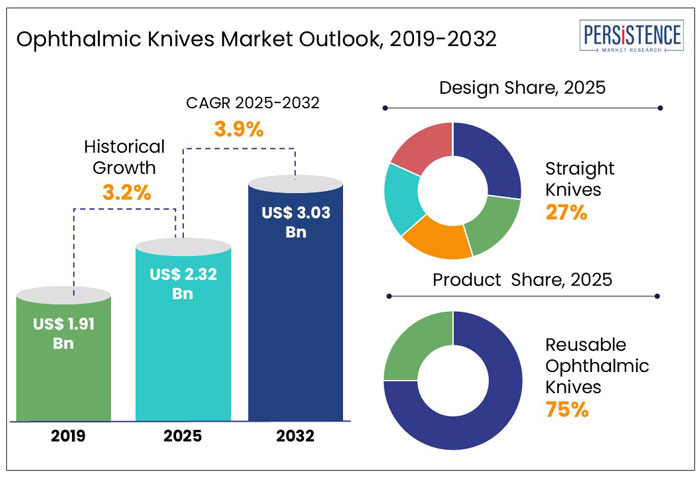Industry: Healthcare
Published Date: March-2025
Format: PPT*, PDF, EXCEL
Delivery Timelines: Contact Sales
Number of Pages: 250
Report ID: PMRREP35165
The global ophthalmic knives market size is anticipated to rise from US$ 2.32 Bn in 2025 to US$ 3.03 Bn by 2032. It is projected to witness a CAGR of 3.9% from 2025 to 2032.
Imagine walking into an eye surgery center today. Unlike a decade ago, when precision was solely in the hands of the surgeon, today’s procedures are backed by cutting-edge technology and meticulously crafted ophthalmic knives. Such tiny yet powerful surgical tools are revolutionizing cataract surgery, glaucoma treatment, and refractive procedures, ensuring minimal invasiveness and maximum precision.
With over 100 million cataract surgeries performed worldwide every year, the need for high-quality ophthalmic instruments has never been greater, which is one of the key factors driving the market growth.
With more than 2.2 billion people globally suffering from vision impairment, the demand for ophthalmic surgical instruments will continue to grow over the forecast period.
Manufacturers must balance affordability and innovation as technology advances, ensuring these life-changing tools are accessible worldwide. Whether for cataract removal, corneal transplant, or LASIK surgery, ophthalmic knives are shaping the future of eye care, one precise cut at a time.

Key Highlights of the Ophthalmic Knives Market
|
Global Market Attributes |
Key Insights |
|
Ophthalmic Knives Market Size (2025E) |
US$ 2.32 Bn |
|
Market Value Forecast (2032F) |
US$ 3.03 Bn |
|
Projected Growth (CAGR 2025 to 2032) |
3.9% |
|
Historical Market Growth (CAGR 2019 to 2024) |
3.2% |
Strong Focus on Manual Precision and Safety Catered to Market Growth Pre-2024
During the historical period from 2019 to 2024, the market witnessed a gradual rise, with a strong focus on manual precision, affordability, and safety.
The demand for cataract and refractive surgeries has surged during this period, with North America holding a substantial market share, while Asia Pacific showed rapid expansion due to growing healthcare infrastructure.
Reusable ophthalmic knives dominated the landscape pre-2024, but concerns about cross-contamination and post-surgical infections started shifting preferences toward single-use disposable knives.
Advent of AI-Assisted Robotic Surgery to Bolster Market Prospects
Over the forecast period, the market is expected to transform significantly. AI-assisted robotic surgery, ultra-thin diamond-blade knives, and femtosecond laser integration will redefine precision in eye procedures.
Asia Pacific will emerge as a key growth hub over the forecast period, driven by increasing surgical volumes and better insurance coverage. As technology evolves, affordability, innovation, and patient safety will be the key drivers shaping the ophthalmic surgical knives market by 2032.
Rising Prevalence of Eye Disorders and Surgeries Drive Market
The growing number of age-related eye disorders like cataracts, glaucoma, and refractive errors is a significant driver for the market.
According to the World Health Organization (WHO), more than 1 billion people globally suffer from vision impairment due to untreated conditions, with cataracts being one of the leading causes.
As a result, the demand for precision surgical instruments, including ophthalmic knives, is surging. Elderly populations, particularly in regions like North America, Europe, and Asia Pacific, require frequent eye surgeries, further fueling market expansion.
The adoption of minimally invasive eye surgeries, which require ultra-sharp, high-precision ophthalmic knives, is also rising. As healthcare facilities strive to improve patient outcomes with advanced surgical techniques, the demand for single-use and reusable ophthalmic knives will continue to grow.
Stringent Regulatory Requirements and Quality Standards to Restrict Market Growth
The ophthalmic surgical instruments market is heavily regulated due to the critical nature of eye surgeries. Regulatory bodies such as the FDA (U.S. Food and Drug Administration) and CE (Conformité Européenne) in Europe impose strict guidelines on the design, material, and sterilization standards for ophthalmic knives.
Manufacturers must invest heavily in clinical trials, compliance certifications, and quality assurance to meet these standards, which can delay product approvals and increase production costs.
Frequent updates to regulations make it challenging for smaller companies to enter the market. Failure to meet these quality benchmarks can lead to product recalls or bans, further restraining market expansion.
Rise of Disposable Ophthalmic Knives for Infection Control Proves to be a Game Changer in Eye Surgery
Surgeons operate under extreme precision, and infection control remains a top priority during any surgery. With the increasing emphasis on patient safety and hygiene, disposable ophthalmic knives eliminate the risk of cross-contamination, ensuring infection-free procedures.
The COVID-19 pandemic heightened awareness about hospital-acquired infections (HAIs), pushing healthcare facilities to shift towards disposable medical instruments.
As regulatory bodies tighten sterilization protocols, the demand for single-use ophthalmic knives is expected to soar, making this segment a lucrative investment for manufacturers.
Reusable ophthalmic knives, though cost-effective in the long run, require meticulous sterilization and handling protocols. Even with stringent cleaning measures, there remains a small but critical risk of cross-contamination.
The COVID-19 pandemic amplified the urgency for safer, single-use medical instruments, accelerating the adoption of disposable ophthalmic knives in hospitals and ambulatory surgical centres.
As the healthcare industry continues to prioritize infection control, the shift towards disposable ophthalmic knives will only accelerate. Their ability to enhance surgical safety, reduce post-operative complications, and improve efficiency makes them a transformative force in ophthalmic surgery.
Straight Knives Dominate with 27% of Market Share with Rising Prevalence of Ocular Illness
The straight knives led the design category of the market due to the rising prevalence of ocular illnesses and surgical procedures. Straight knives are recognized for their essential precision and unilateral blade retraction.
Straight blades exhibit exceptional sharpness and are utilized in many ocular procedures, such as cataracts and retinal surgeries, which is why these are in high demand. Also, the metal blades used in straight knives are disposable, hence diminishing the risk of infection and enhancing their appeal compared to reusable blades.
The MVR knives segment is expected to experience a significant growth rate during the forecast period. MVR blades, or micro vitreoretinal knives, are mostly utilized to create the side port during small incision cataract surgery (SICS) or phacoemulsification (Phaco) cataract surgery of the eye.
MVR knives are often constructed from premium, resilient materials that preserve sharpness and efficacy across numerous applications, which is why these blades are witnessing a surge in demand.
Reusable Ophthalmic Knives Owns 75% of the Market Share Due to their Cost-Effectiveness
Reusable ophthalmic knives have been the leading product segment, accounting for approximately 75% of the market revenue. These knives are crafted from high-quality materials like stainless steel and diamond, ensuring durability, sharpness, and precision for multiple procedures.
Hospitals and surgical centers worldwide rely on reusable ophthalmic surgical knives due to their cost-effectiveness. Unlike single-use ophthalmic knives, which require frequent repurchasing, reusable knives can be sterilized and used multiple times, making them an economical choice, especially for high-volume eye surgeries like cataract removal and corneal transplants.
With superior cutting precision, these knives are highly trusted by surgeons who perform delicate procedures. Thus, reusable ophthalmic knives remain the industry’s preferred choice, balancing cost, efficiency, and surgical precision in eye care.

North America led the global industry, capturing a revenue share of 37%. The region's dominance is ascribed to the rising incidence of ocular illnesses, the continuous expansion of the elderly population, the presence of advanced healthcare facilities, and the widespread use of minimally invasive glaucoma surgeries.
By the end of 2040, Mexico, the second most populous nation in this region, is projected to have 1.27 million cases of glaucoma. Prominent market players, proficient ophthalmologists, favorable healthcare reimbursement policies, and governmental initiatives in nations like the US and Canada propel regional expansion.
The US led the North American market owing to a strong healthcare infrastructure and the existence of major market players.
The widespread usage of technologies and instruments, such as ophthalmic knives, is another market-driving factor. The rising prevalence of ocular diseases and the escalation of ophthalmic surgeries in the region contribute to the US market expansion.
Europe had a substantial revenue share of the global market. The expansion of the European market is primarily propelled by enhanced healthcare infrastructure, the presence of highly proficient surgeons, and an increasing elderly demographic.
Increasing awareness regarding the importance of ocular health and a growing inclination towards minimally invasive surgical techniques are significant factors propelling market expansion. Improved healthcare facilities, increasing disposable income, and increased awareness of eye health are anticipated to propel market growth.
Asia Pacific is expected to experience the highest growth rate during the forecast period. The anticipated growth is attributed to several factors, including the rising incidence of ophthalmic disorders, increased healthcare investment, and the adoption of minimally invasive surgeries.
Increased awareness of the seriousness of eye conditions and the growth of small clinics in urban and rural areas across India, China, and Japan cater to the regional market growth.
The existence of multiple prominent brands, the influx of various multinational industry players in the region's ophthalmic healthcare market, and the expanding economies of nations like India and China are anticipated to foster favorable expansion in this market over the forecast period.
The ophthalmic knives market is highly competitive, with key players focusing on innovation, precision, and safety to meet growing surgical demands.
Leading manufacturers in the industry are investing in advanced materials and ergonomic designs to enhance surgical outcomes. The market is also witnessing increasing competition from emerging players offering cost-effective yet high-quality solutions.
Strategic partnerships, product launches, and technological advancements drive market growth. Factors like the rising prevalence of cataract and refractive surgeries and an aging population further fuel demand. As the industry evolves, players must balance affordability with innovation to maintain a competitive edge.
Key Industry Developments
|
Report Attributes |
Details |
|
Historical Data/Actuals |
2019 - 2024 |
|
Forecast Period |
2025 - 2032 |
|
Market Analysis Units |
Value: US$ Bn/Mn, Volume: As applicable |
|
Geographical Coverage |
|
|
Segmental Coverage |
|
|
Competitive Analysis |
|
|
Report Highlights |
|
|
Customization and Pricing |
Available upon request |
By Design
By Product
By End Use
By Region
To know more about delivery timeline for this report Contact Sales

The market is set to reach US$ 2.32 Bn in 2025.
Alcon, BVI, Diamatrix Ltd., are a few leading players.
The industry is estimated to rise at a CAGR of 3.9% through 2032.
North America is projected to hold the largest share of the industry in 2025.
The market is anticipated to reach a valuation of US$ 3.03 billion by 2032.